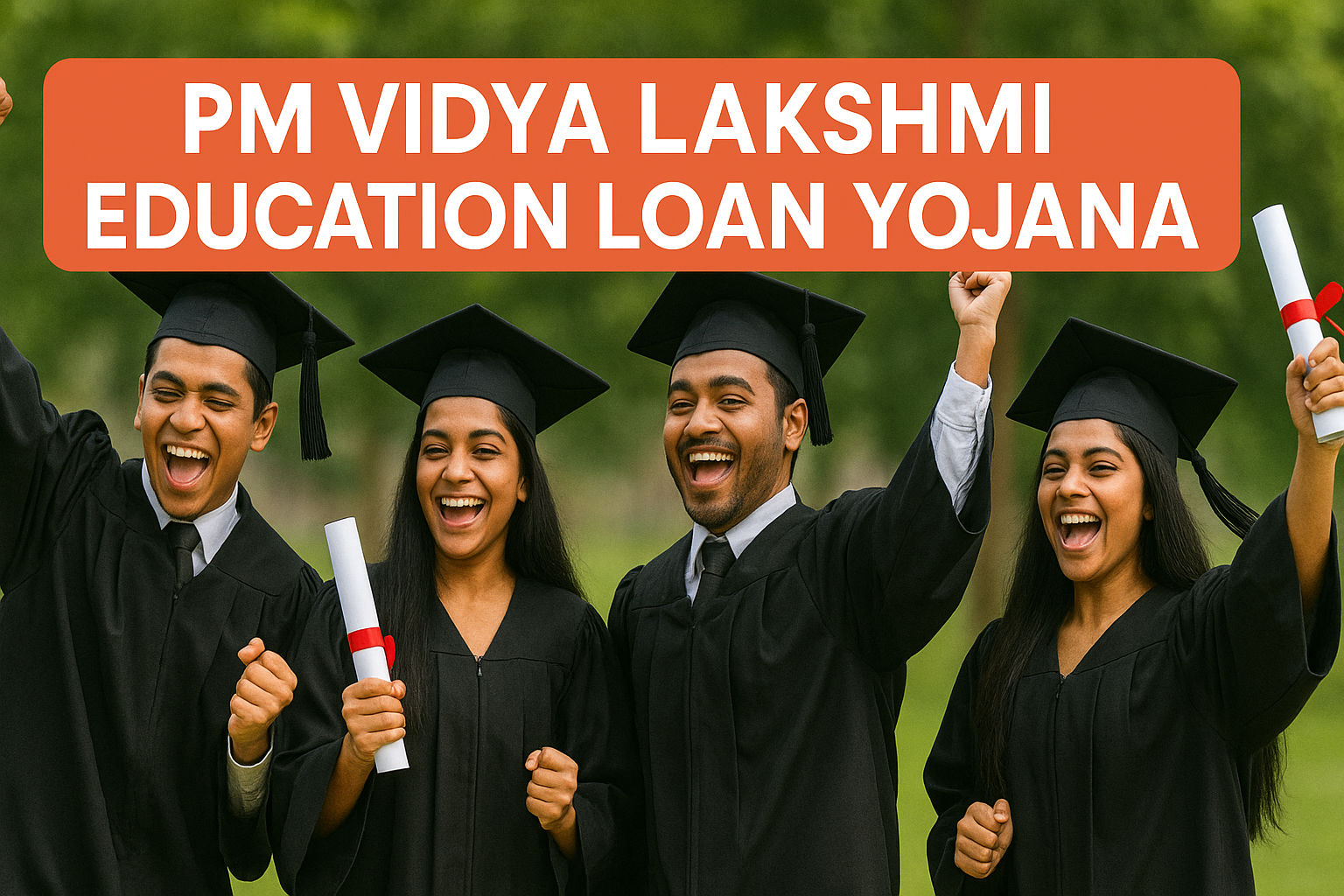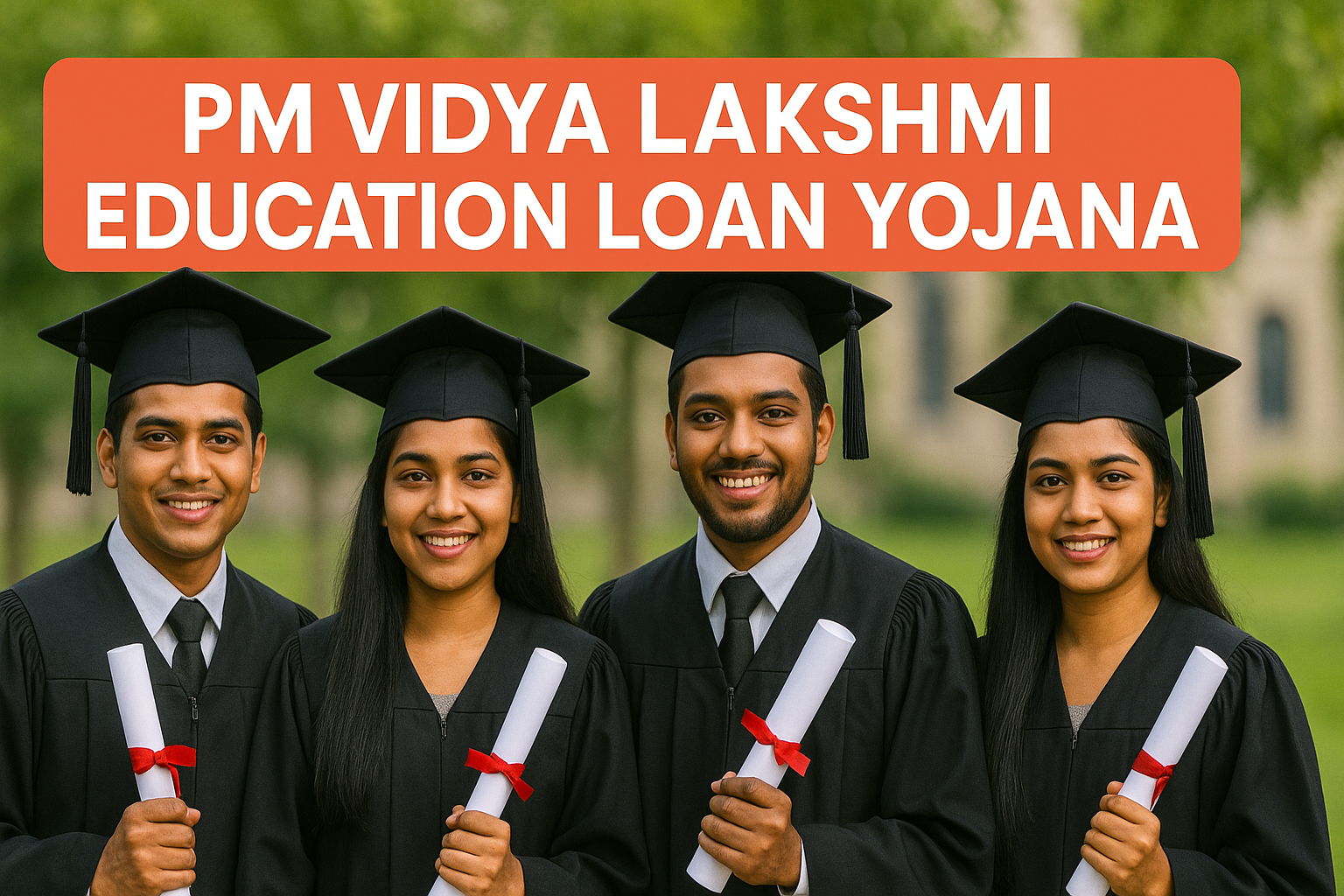PM Vidya Lakshmi Education Loan Yojana
Introduction
This blog provides a detailed explanation of all the important features of the PM Vidya Lakshmi Education Loan Yojana. The article will help to understand for whom this scheme is useful.
Education is a very costly affair nowadays. Especially, the cost of Higher Education is very high. Students seek to take a loan from the bank for their Higher studies. Parents and students struggle with different banks to get an educational loan. PM Vidya Lakshmi Education Loan Yojana tries to make the education loan process easy for students. This scheme provides an easy and transparent platform to apply for an educational loan in different banks and to get a government scholarship. This initiative by the Government aims to make the education loan process transparent and student-friendly.
Under this scheme, a single-window online platform was developed by NSDL e-Gov (National Securities Depository e-Governance Infrastructure Limited) under the guidance of the Department of Financial Services, Ministry of Finance, and the Indian Banks’ Association (IBA).
Key features of PM Vidya Lakshmi Education Loan Yojana
- Students can apply for education loans for multiple banks through a single application form. By filling out the Single Application Form (Common Education Loan Application Form – CELAF), Students can apply to multiple banks. More than 40 banks and financial institutions are associated with the portal.
- Students can avail information about different government scholarships and educational funding schemes.
- They can track the status of their loan application online. This makes the process transparent.
- The government aims to make sure that every deserving student can pursue higher education irrespective of their financial background.
- There are no processing fees for using the portal.
Eligibility Criteria
To apply for an education loan through the Vidya Lakshmi portal, students must meet the following eligibility criteria:
- Nationality: The applicant must be an Indian citizen.
- Educational Qualification: Students must have secured admission to recognized courses in India or abroad.
- Age Limit: The minimum age is generally 18 years. There is no strict upper age limit, but it may vary depending on the bank.
- Academic Record: Applicants should have a good academic record.

Courses Covered
The education loan can be availed for the following types of courses:
- Professional and technical courses in India approved by UGC, AICTE, ICMR, etc.
- Post-graduate courses like MBA, MCA, MS, etc.
- Degree or diploma courses offered by reputed institutions abroad.
- Other job-oriented courses or skill-development courses.
Loan Amount and Expenses Covered
The loan amount and expenses covered vary from bank to bank. However, the general guidelines are:
- Loan Amount:
- Up to ₹10 lakh for studies in India.
- Up to ₹20 lakh (and sometimes more) for studies abroad.
- Expenses Covered:
- Tuition fees and examination fees.
- Hostel and accommodation charges.
- Cost of books, equipment, and travel expenses (if abroad).
- Any other reasonable expense required to complete the course.
Interest Rate and Repayment
- Interest Rate: Interest rates may differ for each bank. Most banks offer education loans at a floating interest rate linked to the Repo Rate or MCLR. The rates generally range from 8% to 12% per annum, depending on the bank and the loan amount.
- Moratorium Period: Usually, repayment starts one year after the completion of the course or six months after getting a job, whichever is earlier.
- Repayment Tenure: The repayment period can range from 5 to 15 years, depending on the bank and the loan amount.
Banks & int. rates of banks participating in Vidya Lakshmi Portal
Over 40 banks and financial institutions are part of the Vidya Lakshmi Yojana. Below are some prominent names and their approx. loan interest rates.
- State Bank of India (SBI) — ~7.50%
- Punjab National Bank (PNB) — ~7.50%
- Bank of Baroda — 7.10%
- Canara Bank — 7.00%
- HDFC Bank — ~8.75%
- ICICI Bank — ~8.80%
- Union Bank of India — ~7.85%
- Indian Overseas Bank — ~8.70%
How to Login and Apply for Education Loan through Vidya Lakshmi Portal?
Please follow the following steps.
- Visit the site www.vidyalakshmi.co.in. Register on Vidya Laxmi Portal.
- Click New User and Register now. Create a student account using a valid email ID.
- Then log in to your account and fill CELAF (Common Education Load Application form) with all the required details. Details include personal, academic, and financial details.
- Choose the preferred bank and schemes you want to apply for. Choose three banks of your choice. Submit the application
- Once the application is submitted, you can track the status of your application in the portal. The Bank can contact you for further processing. You can also contact the bank for further follow-up.
Documents Required
Though the exact list may vary across banks, the common documents required include:
- Proof of identity (Aadhaar card, PAN card, etc.)
- Proof of residence
- Academic records (mark sheets, admission letter, etc.)
- Income proof of parents/guardians
- Passport-size photographs
- Bank account details
Govt. subvention (Subsidy) on the interest amount of the loan
- During the moratorium period, there is full interest subvention (subsidy – under PM-USP CSIS) for students from families having an annual income up to Rs 4.5 Lakh on an education loan up to 10 Lakh. The moratorium period is the course duration period plus one year.
- During the moratorium period, there is 3% interest subsidy (subvention) for students from families having an annual income up to Rs 8 Lakh on an education loan up to 10 Lakh.
- If annual family income is above ₹ 8 lakh, you can still apply for an education loan under this scheme, but you will not get the interest subsidy.
- These criteria are current as of the 2025-26 academic year and apply to admissions in the 860 designated Quality Higher Educational Institutions (QHEIs) in India.
Method of repayment and Period
- Repayment of the Education loan starts after the moratorium period. The moratorium period refers to the course period plus one year. The student has to pay only interest on the loan during the moratorium period. There is no need to pay the principle amount. However, payment of interest during this period is optional with some banks.
- You can choose the repayment period from 5 to 15 Years. Loan repayment is done in equal monthly instalments after the moratorium period.
- Prepayment charges are not applicable if you decide to pay early.
This makes the scheme relatively flexible and student-friendly for loan repayment.
Points to Keep in mind
- Loan approval is at the sole discretion of the bank. Final sanction authority is the bank; you have to accept their decision.
- A bank can ask for a guarantor or collateral for loans above certain limits.
- The rate of interest will vary from bank to bank. Students and parents should compare the interest rates of different banks before finalising a decision.
- All the documents required by the bank should be submitted in time to avoid a delay in sanction.
Conclusion
The PM Vidya Lakshmi Education Loan Yojana is a great initiative by the Indian Government to finance higher education for needy students of India. This scheme gives students a single platform to apply for an educational loan in different banks. This makes the process of educational loans more transparent and simple. Students planning for higher education in India and abroad can take advantage of this scheme. 40 banks and financial institutions are available in this scheme. This scheme will help many needy students to pursue their dream of higher education, financially stress-free.
For more information and to apply, visit www.vidyalakshmi.co.in
Frequently Asked Questions.
1. What is the PM Vidya Lakshmi Scheme, and who is eligible?
This is a Government of India initiative for giving educational loans to deserving students for higher education. Guarantor and collaterals are not required up to a certain amount. Those Indian students who are pursuing higher studies in Quality Higher Education Institutions (QHEIS) are eligible to apply under this scheme.
2.. How much loan can one avail under PM Vidya Lakshmi Scheme?
There is no maximum limit fixed under the scheme. But approx limits are as follows.
(i) For studying in India — It is Rs. 10 Lakh
(ii) For studying abroad — Rs. 20 Lakh
3. What interest subvention or subsidy is provided under the PM Vidya Lakshmi Scheme?
- During the moratorium period, there is full interest subvention (subsidy – under PM-USP CSIS) for students from families having an annual income up to Rs 4.5 Lakh on an education loan up to 10 Lakh. The moratorium period is the course duration period plus one year.
- During the moratorium period, there is 3% interest subsidy (subvention) for students from families having an annual income up to Rs 8 Lakh on an education loan up to 10 Lakh.
- If annual family income is above ₹ 8 lakh, you can still apply for an education loan under this scheme, but you will not get the interest subsidy.
4. What is the maximum repayment tenure under PM Vidyalaxmi scheme?
The maximum tenure is 15 Years, and the Minimum Tenure is 5 Years.
5. What is the security requirement for loans under PM Vidyalakshmi?
There is no need for a guarantor or collateral for loans under the PM Vidyalaxmi Scheme. But in certain cases where the loan amount is high, the bank can ask for guarantors or collateral security.
6. How to apply on the Vidya Lakshmi portal?
Please follow the following steps.
- Visit the site www.vidyalakshmi.co.in. Register on Vidya Laxmi Portal.
- Click New User and Register now. Create a student account using a valid email ID.
- Then, log in to your account and fill out the CELAF (Common Education Load Application form) with all the required details. Details include personal, academic, and financial details.
- Choose the preferred bank and schemes you want to apply for. Choose three banks of your choice. Submit the application
- Once the application is submitted, you can track the status of your application in the portal. The Bank can contact you for further processing. You can also contact the bank for further follow-up.
The reader will also like to read about the following topics
4. Bull vs Bear Phase in the Stock Market
5 . XIRR vs CAGR vs Absolute Return
6. Nifty 50 vs Nifty Next 50 vs Nifty 100
7. Top 5 gold ETF funds in India

